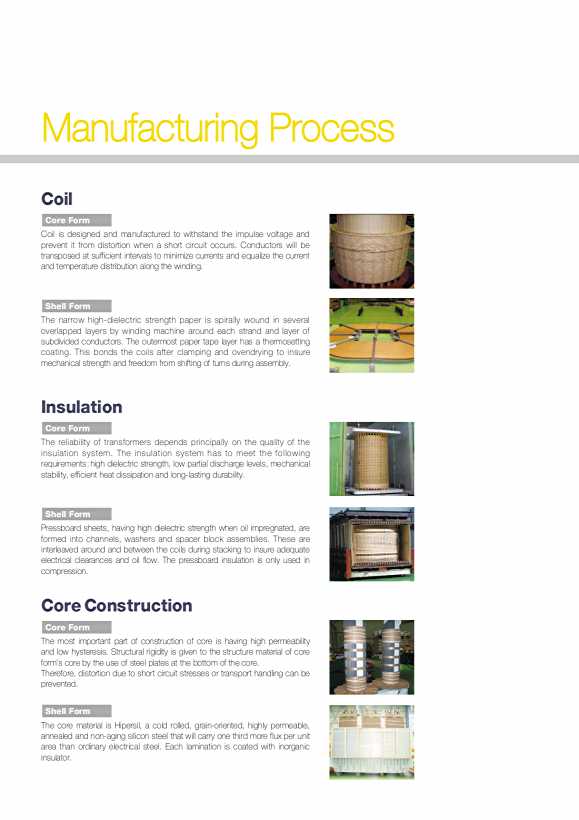

Manufacturing PProcess Coil Core Form Coil is designed and manufactured to withstand the impulse voltage and prevent it from distortion when a short circuit occurs. Conductors will be transposed at sufficient intervals to minimize currents and equalize the current and temperature distribution along the winding. Shell Form The narrow high-dielectric strength paper is spirally wound in several overlapped layers by winding machine around each strand and layer of subdivided conductors. The outermost paper tape layer has a thermosetting coating. This bonds the coils after clamping and ovendrying to insure mechanical strength and freedom from shifting of turns during assembly. Insulation Core Form The reliability of transformers depends principally on the quality of the insulation system. The insulation system has to meet the following requirements:high dielectric strength, low partial discharge levels, mechanical stability, efficient heat dissipation and long-lasting durability. Shell Form Pressboard sheets, having high dielectric strength when oil impregnated, are formed into channels, washers and spacer block assemblies. These are interleaved around and between the coils during stacking to insure adequate electrical clearances and oil flow. The pressboard insulation is only used in compression. Core Construction Core Form The most important part of construction of core is having high permeability and low hysteresis. Structural rigidity is given to the structure material of core form’s core by the use of steel plates at the bottom of the core. Therefore, distortion due to short circuit stresses or transport handling can be prevented. Shell Form The core material is Hipersil, a cold rolled, grain-oriented, highly permeable, annealed and non-aging silicon steel that will carry one third more flux per unit area than ordinary electrical steel. Each lamination is coated with inorganic insulator.
I 12 13 Power Transformers Core and Coil Assembly Core Form Coils are sized and clamped after assembly with the core by being pressed with a special hydraulic fixture, then clamped to the end and lock plates. In the case of core-form transformer, core and coil are supported by vertically connecting leg core to lower yoke and assembling each winding to leg core where the upper tempering iron is assembled on top of the winding. Shell Form The coil assemblies are lowered into the form-fit tank bottom and wedged securely in place. Hipersil laminations, stacked on fill blocks around the coils and on a T-beam through the coil openings, are applied with overlapped joints to increase mechanical strength and keep exciting current at a minimum. The core section in the coil openings are wedged at the top to compress the core and to hold the coil assembly rigid. Wedges are driven between phases, top fill blocks are positioned and vertical wood pieces, with pressboard channels that are connected between the top and bottom fill blocks. Tanking Core Form The transformer is provided with a suitable steel tank of substantial construction which is oil-tight and gas-tight. Also, all gaskets are made of materials which do not deteriorate under service conditions. The tank has sufficient strength to withstand an internal pressure of full vacuum and vacuum drying without damage or permanent deformation. In the case of core-form transformer the joint between the tank and cover is provided with suitable flange and gaskets at top of the tank so that the assembly service is oil-tight and gas-tight. Shell Form The form-fit shell form tank designed and built into a unit assembly of high inherent strength withstands the effects of vibration, handling, application of vacuum during the oil filling and prevents oil leakage with suitable gaskets. The form-fit top section, with end frames and side channels welded inside, makes the core into a rigid body when it is lowered over the wood pieces, pulled down and welded to the tank bottom.